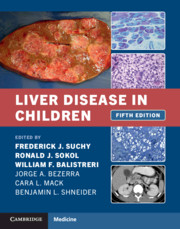Book contents
- Liver Disease in Children
- Liver Disease in Children
- Copyright page
- Contents
- Contributors
- Preface
- Section I Pathophysiology of Pediatric Liver Disease
- Section II Cholestatic Liver Disease
- Chapter 8 Approach to the Infant with Cholestasis
- Chapter 9 Medical and Nutritional Management of Cholestasis in Infants and Children
- Chapter 10 Neonatal Hepatitis and Congenital Infections
- Chapter 11 Biliary Atresia and Other Disorders of the Extrahepatic Bile Ducts
- Chapter 12 Neonatal Jaundice and Disorders of Bilirubin Metabolism
- Chapter 13 Familial Hepatocellular Cholestasis
- Chapter 14 Alagille Syndrome
- Chapter 15 Intestinal Failure Associated Liver Disease
- Chapter 16 Diseases of the Gallbladder in Infancy, Childhood, and Adolescence
- Section III Hepatitis and Immune Disorders
- Section IV Metabolic Liver Disease
- Section V Other Considerations and Issues in Pediatric Hepatology
- Index
- References
Chapter 15 - Intestinal Failure Associated Liver Disease
from Section II - Cholestatic Liver Disease
Published online by Cambridge University Press: 19 January 2021
- Liver Disease in Children
- Liver Disease in Children
- Copyright page
- Contents
- Contributors
- Preface
- Section I Pathophysiology of Pediatric Liver Disease
- Section II Cholestatic Liver Disease
- Chapter 8 Approach to the Infant with Cholestasis
- Chapter 9 Medical and Nutritional Management of Cholestasis in Infants and Children
- Chapter 10 Neonatal Hepatitis and Congenital Infections
- Chapter 11 Biliary Atresia and Other Disorders of the Extrahepatic Bile Ducts
- Chapter 12 Neonatal Jaundice and Disorders of Bilirubin Metabolism
- Chapter 13 Familial Hepatocellular Cholestasis
- Chapter 14 Alagille Syndrome
- Chapter 15 Intestinal Failure Associated Liver Disease
- Chapter 16 Diseases of the Gallbladder in Infancy, Childhood, and Adolescence
- Section III Hepatitis and Immune Disorders
- Section IV Metabolic Liver Disease
- Section V Other Considerations and Issues in Pediatric Hepatology
- Index
- References
Summary
Intestinal failure (IF) is defined as the end result of any gastrointestinal disorder in which functional intestinal mass is insufficient to allow adequate growth, hydration, and electrolyte balance in children and adults. Inherent in this definition is the requirement for parental nutrition (PN), which is provided to maintain fluid, energy, protein, electrolyte, and micronutrient delivery in the absence of adequate intestinal function. In the pediatric population, IF may be the end result of various primary etiologies, although the most common is short bowel syndrome (SBS) following congenital or acquired disorders, including necrotizing enterocolitis (NEC), small intestinal atresia, volvulus, and gastroschisis. Table 15.1 summarizes the most common etiologies of pediatric IF.
- Type
- Chapter
- Information
- Liver Disease in Children , pp. 242 - 254Publisher: Cambridge University PressPrint publication year: 2021
References
References
Websites for Further Information
Oley Foundation: https://oley.org/default.aspx
American Society for Parenteral and Enteral Nutrition: www.nutritioncare.org/
Short Bowel Syndrome Foundation: http://shortbowelfoundation.org/
GI Kids (NASPGHAN Foundation): https://gikids.org/digestive-topics/short-bowel-syndrome/

